Modified Parbati-Kalisindh- Chambal-ERCP (PKC-ERCP) Link Project (Indian Express)
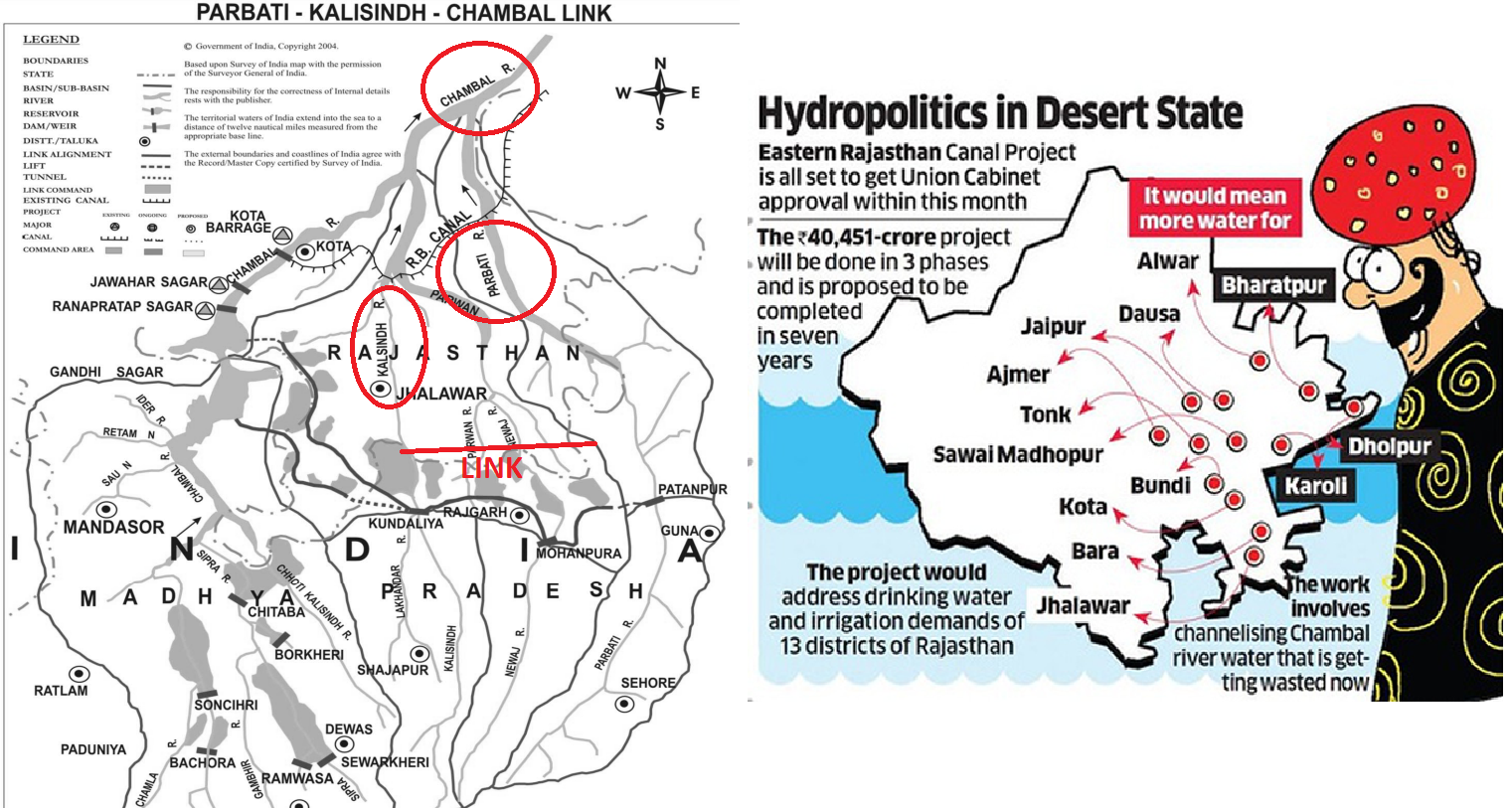
- 29 Jan 2024
Why is it in the News?
An MoU was signed by Rajasthan and MP with the Union Ministry of Jal Shakti Sunday for implementation of the Modified Parbati-Kalisindh-Chambal-ERCP (Modified PKC-ERCP) Link Project.
What is the Modified PKC-ERCP?
- The Modified PKC-ERCP is an inter-state river linking project.
- A Memorandum of Agreement (MoA) will be finalised among Rajasthan, Madhya Pradesh, and the Centre, covering the sharing of water, exchange of water, sharing of costs and benefits, implementation mechanisms, arrangements for management and control of water in the Chambal basin, etc.
What is the PKC link project?
- The Parbati-Kalisindh-Chambal (PKC) link project is one of the 30 links included in the National Perspectives Plan formulated by the erstwhile Union Ministry of Irrigation (now Ministry of Water Resources) and the Central Water Commission in the year 1980.
- As per the National Water Development Agency (NWDA), the preliminary feasibility report of the Kalisindh-Chambal link canal project was prepared and circulated to the states concerned in September 1991.
- The report proposed the diversion of water from river Newaj (a tributary of Kalisindh) and Kalisindh to the river Chambal at either the Rana Pratap Sagar dam or the Gandhi Sagar dam.
- Rajasthan came up with the proposal of the ERCP in 2019, and to utilise water resources optimally, the Task Force for Interlinking of Rivers (TFILR) discussed its merger with the PKC link project.
- This integration was approved by the Special Committee for Interlinking of Rivers in December 2022.
What is the ERCP?
- The Eastern Rajasthan Canal Project (ERCP) is aimed at the intra-basin transfer of water within the Chambal basin, by utilising surplus monsoon water available in the Kalisindh, Parvati, Mej and Chakan subbasins and diverting it into water deficit sub-basins of Banas, Gambhiri, Banganga and Parbati.
- This will provide drinking and industrial water to 13 districts of eastern Rajasthan, namely Alwar, Bharatpur, Dholpur, Karauli, Sawai-Madhopur, Dausa, Jaipur, Ajmer, Tonk, Bundi, Kota, Baran, and Jhalawar.
What are the benefits of the modified project?
- According to the Jal Shakti Ministry, the link project proposes to provide drinking and industrial water in 13 districts of eastern Rajasthan, and Malwa and Chambal regions of Madhya Pradesh, apart from providing irrigation in 2.8 lakh ha. area (or more) each in both states (total of 5.6 lakh ha or more).
What is River Interlinking?
- River Interlinking involves the creation of artificial channels to connect rivers and water bodies, facilitating the transfer of water from regions of surplus to those facing deficits.
- Importance of River Interlinking:
- Disaster Management: River Interlinking plays a crucial role in mitigating floods and droughts, aiding in effective disaster management strategies.
- Economic Benefits: It offers economic advantages such as enhanced irrigation facilities, increased hydro-power generation capacity, and improved inland navigation, contributing to regional development.
- Ecological Restoration: River Interlinking initiatives contribute to the restoration of river ecosystems and provide support to biodiversity in water-deficient regions, fostering ecological balance.
- Concerns Associated with River Interlinking:
- Biodiversity Loss: One major concern revolves around the potential loss of biodiversity resulting from altering natural river courses and habitats.
- Community Displacement: Another significant issue is the displacement of communities residing in areas affected by river interlinking projects, highlighting social and humanitarian challenges.
About the National Perspective Plan:
- The National Perspective Plan was formulated in 1980 under the purview of the Ministry of Irrigation (currently known as the Ministry of Jal Shakti) and the Central Water Commission.
- Objective:
- The plan aims to address regional disparities by facilitating the inter-basin transfer of water resources, thereby minimizing imbalances across different regions of the country.
- Components:
- The plan consists of 30 link projects categorized into two main components:
- the Himalayan component, comprising 14 projects, and
- the Peninsular component, consisting of 16 projects.
- The plan consists of 30 link projects categorized into two main components:
World's First 'Black Tiger Safari', to be Established in Odisha (TOI)
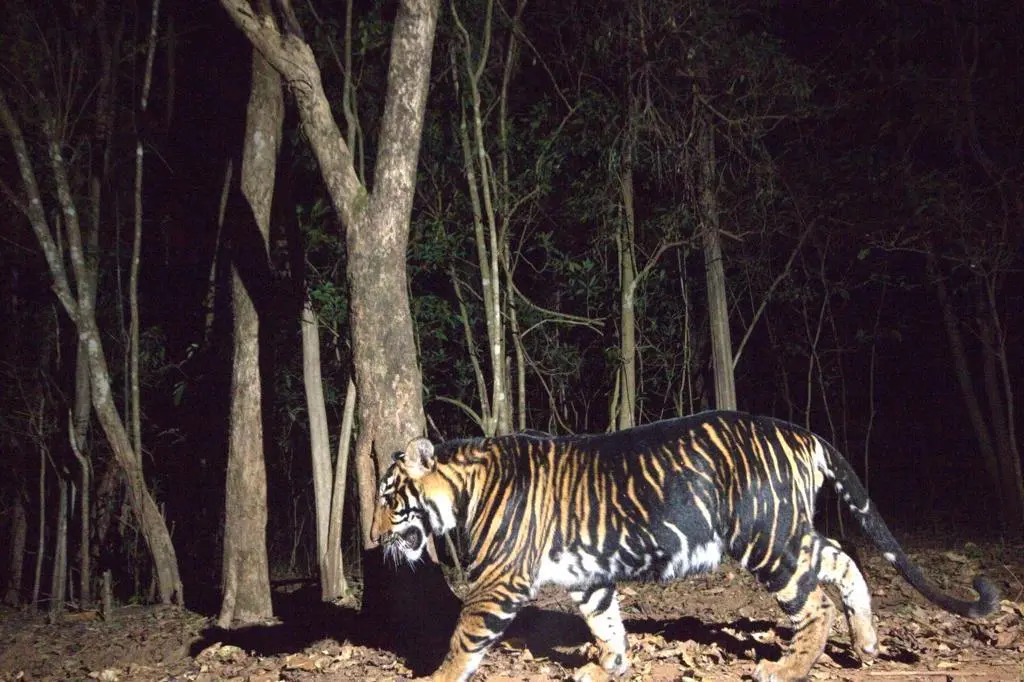
- 29 Jan 2024
Why is it in the News?
Odisha is gearing up to provide an unparalleled experience to visitors through its upcoming black tiger safari, offering a rare glimpse into the lives of these majestic creatures in their natural habitat.
What are Black Tigers or Melanistic Tigers?
- Black tigers, also known as melanistic tigers, are a unique phenomenon resulting from a genetic condition called melanism.
- Melanism causes an increased production of melanin, a pigment responsible for hair, eye, and skin colouration, resulting in black or nearly black skin, feathers, or hair in animals.
- In Simlipal Tiger Reserve, many royal Bengal tigers belong to a distinct lineage characterized by higher-than-normal levels of melanin.
- These tigers exhibit black and yellow interspersed stripes on their coats, though they are not entirely black.
- Therefore, they are more accurately described as pseudo-melanistic.
- As per the 2022 All-India Tiger Estimation, 16 tigers were recorded in Similipal Tiger Reserve, out of which 10 were melanistic.
- However, ongoing tiger surveys conducted by the state government suggest that the actual number of royal Bengal tigers in Similipal Tiger Reserve may be higher than reported by the National Tiger Conservation Authority.
- Factors Contributing to (Pseudo) Melanism:
- Research conducted by the National Centre for Biological Sciences (NCBS) in Bengaluru indicates that a single mutation in the gene Transmembrane Aminopeptidase Q (Taqpep) is responsible for the enlargement or spreading of black stripes into the yellow background of black tigers.
- Genetic analyses and computer simulations suggest that Similipal's black tigers may have originated from a very small founding population of tigers and are likely inbred.
- Additionally, the isolation of tigers in Similipal Tiger Reserve leads to breeding within the population, further contributing to the prevalence of melanism among these tigers.
About Similipal Tiger Reserve (STR):
- Similipal, which derives its name from the ‘Simul’ (Silk Cotton) tree, is a national park and a Tiger Reserve situated in the northern part of Orissa’s Mayurbhanj district.
- It spans an expansive area of 2,750 square kilometres (1,060 square miles), bordering Jharkhand and West Bengal.
- Similipal Tiger Reserve is a key component of the Mayurbhanj Elephant Reserve, which encompasses three protected areas:
- Similipal Tiger Reserve
- Hadagarh Wildlife Sanctuary, and
- Kuldiha Wildlife Sanctuary
- Biodiversity: Similipal is renowned for its rich biodiversity, boasting a diverse array of wildlife including the majestic Bengal tiger, the iconic Asian elephant, the formidable gaur, and the elusive chausingha.
- Recognized as a UNESCO World Network of Biosphere Reserves site since 2009, it stands as Asia's second-largest biosphere reserve, following the Gulf of Kachchh in Gujarat.
- Notably, Similipal Tiger Reserve holds the distinction of being the sole natural habitat in India for melanistic royal Bengal tigers, adding to its ecological significance.
The Procedure of Appointment of a Chief Minister (The Hindu)
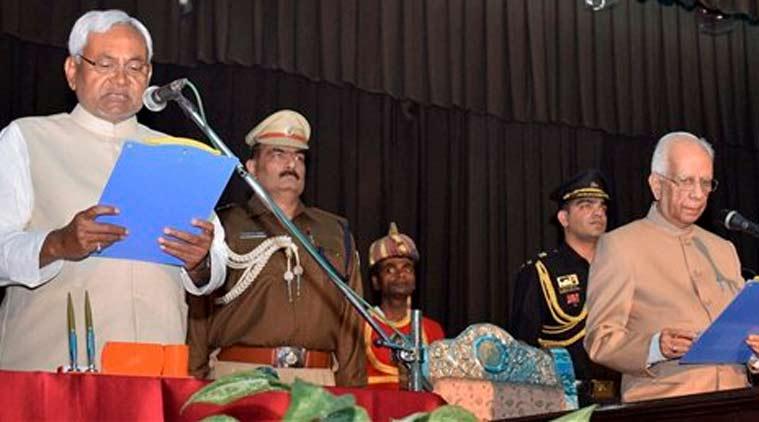
- 29 Jan 2024
Why is it in the News?
Janata Dal (United) president Nitish Kumar took oath as Bihar Chief Minister for a record ninth time on Sunday, returning to the BJP-led National Democratic Alliance just 18 months after he left it, in his fifth switch in political loyalties since 2015.
About Chief Minister:
- According to Article 163 of the Indian Constitution, each state shall have a Council of Ministers led by the Chief Minister (CM) to assist and provide advice to the Governor in carrying out the state's functions.
- In the parliamentary system of governance, the Chief Minister holds the actual executive authority within states.
- While the Governor serves as the ceremonial head of the state, the Chief Minister serves as the head of the government.
- In the Indian political framework, the Chief Minister's role is analogous to that of the Prime Minister at the national level.
Appointment Process of Chief Minister:
- The Constitution of India does not lay down specific criteria for the appointment of a Chief Minister.
- Article 164 of the Indian Constitution stipulates that the Governor is responsible for appointing the Chief Minister, albeit with certain limitations.
- Traditionally, the leader of the largest party in the state legislature is typically chosen as the Chief Minister, following parliamentary conventions.
- Even individuals who are not members of the state legislature (both Houses) can be appointed as Chief Minister for a temporary period of six months, during which they must secure election or nomination (in the case of a bicameral legislature).
- In situations where no single party or pre-poll coalition secures a majority in the assembly (known as a hung assembly), the Governor exercises discretionary powers to appoint the Chief Minister, relying on individual judgment.
- The Constitution does not mandate the Chief Minister-elect to demonstrate majority support in the state assembly before assuming office.
- However, after the formation of the ministry, the Governor may request the Chief Minister to prove majority support within a reasonable timeframe.
Oath and Affirmation of Chief Minister:
- The third Schedule of the Indian Constitution outlines the "Forms of Oaths or Affirmations" to be taken by public officials.
- Typically, the Chief Minister's oath, solemnly administered by the Governor, constitutes a formal commitment to uphold the constitution and execute the responsibilities of the position with integrity and diligence.
Roles and Responsibilities of the Chief Minister:
- The Chief Minister serves as the principal advisor to the Governor on matters pertaining to the convening and adjournment of state legislative sessions.
- As the head of the State Legislative Assembly, the Chief Minister acts as the primary liaison between the Governor and the Council of Ministers.
- The Chief Minister possesses the authority to propose the dissolution of the legislative assembly to the Governor when deemed necessary.
- Additionally, the Chief Minister assumes the role of vice-chairman of the relevant zonal council on a rotational basis, serving a term of one year.
Alabama in USA Carried Out the First Ever Execution Using Nitrogen Gas (Indian Express)
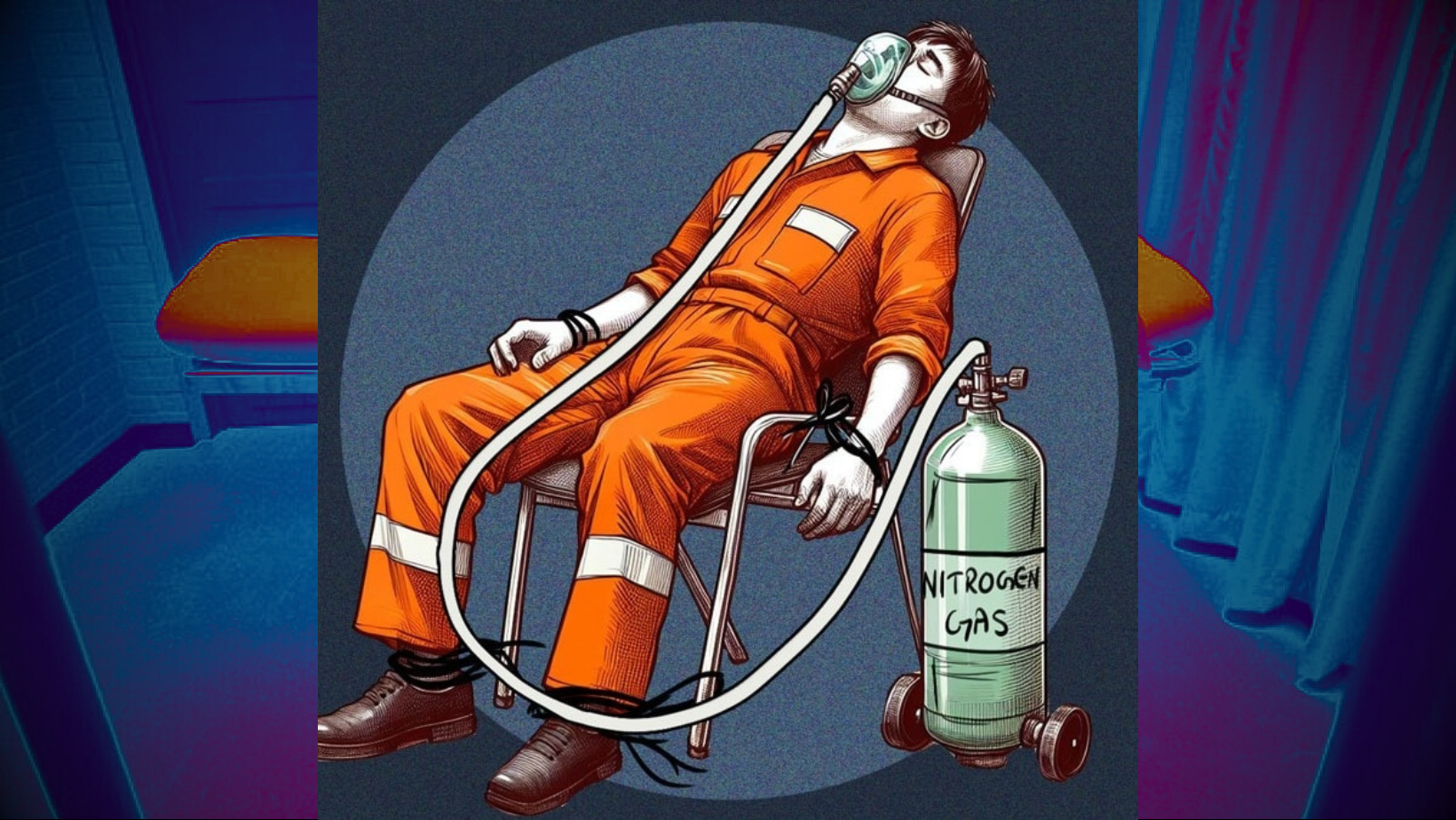
- 29 Jan 2024
Why is it in the News?
Alabama inmate Kenneth Smith was executed on January 25 by nitrogen hypoxia, marking the United States’ first execution using the method, and the first time in over four decades that a new method of execution was introduced since lethal injection was first used in 1982.
News Summary:
- An Alabama death row inmate has been put to death by nitrogen gas, in the first known execution of its kind in the US.
- His case marks the first known execution by nitrogen hypoxia, which his lawyers had argued amounted to a form of “cruel and unusual punishment”.
- Death by nitrogen gas is an untested procedure, and its opponents say it can cause unnecessary suffering.
- Kenneth Smith, 58, was a contract killer who had been on the death row since 1996.
What is Nitrogen Hypoxia?
- Nitrogen hypoxia is a style of execution wherein an inmate is made to inhale nitrogen instead of oxygen, leading to gradual asphyxiation.
- To achieve this, a respirator mask is placed over the head of the inmate on death row.
- While the air we breathe is made up of 80 per cent nitrogen, it exists in combination with oxygen, rendering the colourless, odourless gas harmless.
- However, if a person is deprived of oxygen and made to breathe in just nitrogen, the gas proves lethal.
- When a high concentration of nitrogen is inhaled, it replaces the oxygen in the body and disables the respiratory system, causing death.
Why Nitrogen Hypoxia?
- Nitrogen hypoxia is the first new method of execution to be introduced since 1982 when lethal injections began being used.
- The drug needed to administer lethal injections to inmates on death row became harder to access over time, pushing authorities to scout for alternatives.
- Further, there were reports of a surge in complications associated with the procedure as well.
- As of now, only three states in the United States have approved the use of nitrogen gas to execute death row inmates, namely, Alabama, Oklahoma, and Mississippi.
Is Nitrogen Hypoxia Ethical?
- There is little research regarding death by nitrogen hypoxia.
- When the State is considering using a novel form of execution that has never been attempted anywhere, the public has an interest in ensuring the State has researched the method adequately and established procedures to minimise the pain and suffering of the condemned person.
- The risks associated with this method of execution include the risks surrounding the chances of a gas leak if the mask is not secured well on the inmate.
- The law requires that this execution not be cruel.
Key facts about Nitrogen:
- The air around us, the atmosphere, is made up of about 78% nitrogen and only 21% oxygen.
- The rest comprises water vapour, argon, neon, helium, hydrogen and xenon.
- Those are known as "permanent gases".
- There is also a range of "variable gases" in the atmosphere.
- They include methane, ozone and carbon dioxide — with concentrations that can vary from day to day and region to region.
- At a concentration of 78% in the atmosphere, nitrogen is safe to breathe.
- But it grows dangerous and potentially fatal once levels of nitrogen reach 80% or more.
- Nitrogen has no odour, is tasteless, and colourless.
- Nitrogen gas is inert, but certain soil bacteria can "fix" nitrogen into a usable form for plants and animals.
- French chemist Antoine Laurent Lavoisier named nitrogen azote, meaning without life.
- Nitrogen was sometimes referred to as 'burnt' or 'dephlogisticated' air.
- Nitrogen compounds are found in foods, fertilizers, poisons, and explosives.
- It is responsible for the orange-red, blue-green, blue-violet, and deep violet colours of the aurora.
- Nitrogen has a valence of 3 or 5.
- Discovery: Scottish physician Daniel Rutherford in 1772
- Nitrogen is the fifth most abundant element in the universe.
PM Modi Inaugurates the Diamond Jubilee Celebration of the SC (The Hindu)
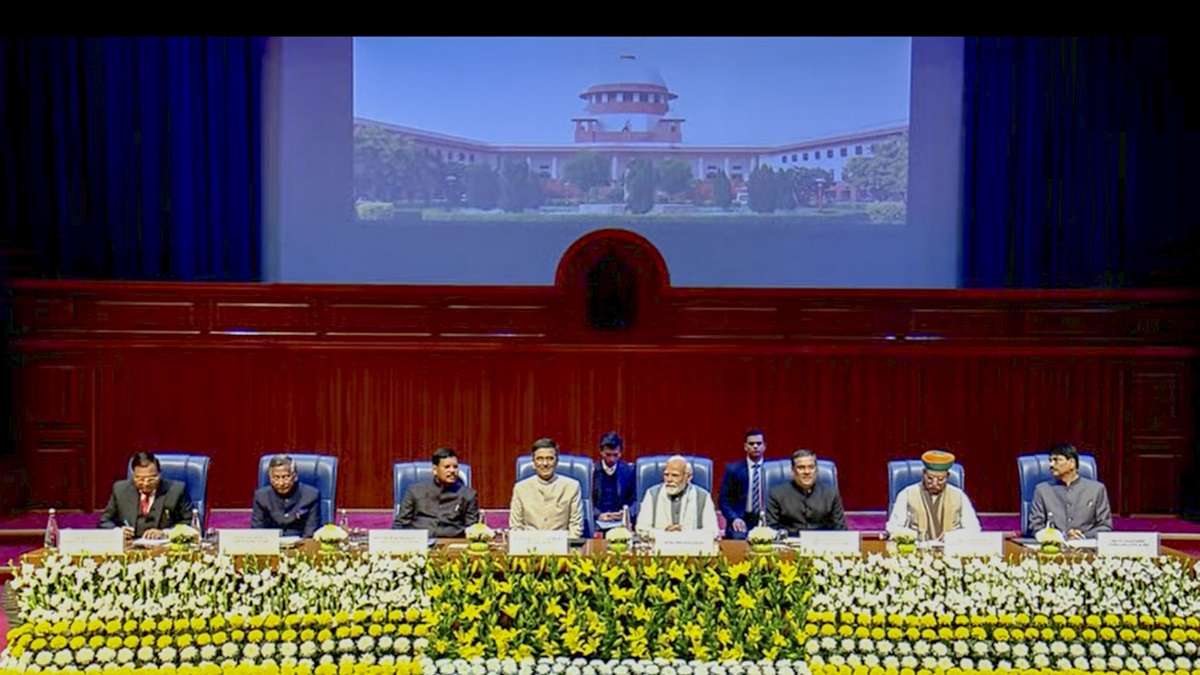
- 29 Jan 2024
Why is it in the News?
Prime Minister Narendra Modi on Sunday said ?800 crore has been approved for the expansion of the Supreme Court building complex while underlining that “ease of justice is the right of every Indian citizen and the Supreme Court is its medium”.
About the Supreme Court of India (SC):
Historical Context:
- The Supreme Court of India, inaugurated on January 26, 1950, coinciding with India's Republic Day, stands as the apex judicial body of the nation.
- Article 124 of the Constitution states that “There shall be a Supreme Court of India.”
- Situated on Tilak Marg, New Delhi, it initially operated from the Parliament House before relocating to its current edifice.
- The present building of the Supreme Court was inaugurated on August 4, 1958, by the first President of India, Dr. Rajendra Prasad.
Judicial Composition:
- The original Constitution envisioned a Supreme Court comprising a Chief Justice and seven puisne Judges, with subsequent increments authorized by Parliament to meet the burgeoning caseload.
- Presently, the Supreme Court consists of 34 Judges, including the Chief Justice, who convene in smaller benches of two or three, while larger benches of five or more, known as Constitution Benches, address critical constitutional matters or resolve conflicting decisions.
Jurisdiction and Powers:
- Endowed with original, appellate, and advisory jurisdiction, the Supreme Court serves as the final interpreter of the Constitution and the ultimate court of appeal.
- Its exclusive original jurisdiction extends to disputes between the Government of India and States or between States (Article 131), while Article 32 empowers it to safeguard Fundamental Rights through writs.
- Additionally, the Supreme Court exercises appellate jurisdiction over High Courts and other judicial bodies, with the power to entertain appeals on substantial questions of law and issue special leave to appeal under Article 136.
- Special advisory jurisdiction is vested in the Supreme Court under Article 143, allowing it to deliberate on matters referred by the President of India.
Judicial Powers and Enforcement:
- Empowered to issue writs and directions for the enforcement of Fundamental Rights, the Supreme Court wields authority to punish for contempt of court, including self-contempt.
- It can reconsider its final judgments through curative petitions and holds the authority to transfer cases between High Courts and adjudicate on election petitions.
Binding Authority:
- As the apex judicial body, judgments rendered by the Supreme Court carry binding precedent on all subordinate courts and tribunals across India, ensuring uniformity and consistency in legal interpretation and application.
